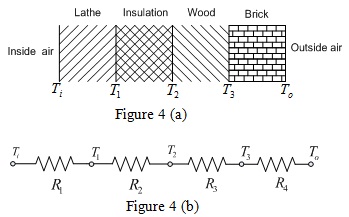Questions:
Linear Algebra : Calculating heat loss through a wall
Engineers use the concept of thermal resistance R to predict the rate of heat loss through a building wall in order to determine the heating system's requirements. This concept relates the heat flow rate q through a material to the temperature difference ΔT across the material: q = ΔT/R. This relation is like the voltage-current relation for an electrical resistor: i =V/R. So the heat flow rate plays the role of electrical current, and the temperature difference plays the role of the voltage difference v. The SI unit for q is watt/meter2. A watt is 1 joule/second.
The wall shown in Figure 4(a) consists of four layers: an inner layer of plaster/lathe 10 mm thick, a layer of fiberglass insulation 125 mm thick, a layer of wood 60 mm thick, and an outer layer of brick 50 mm thick. Figure 4(b) shows the electrical equivalent circuit.

If we assume that the inner and outer temperatures Ti and T0 have remained constant for some time, then the heat energy stored in the layers is constant; thus the heat flow rate through each layer is the same. Applying conservation of energy gives the following equations:
q = 1/R1 (Ti-T1) = 1/R2(T1-T2) = 1/R3(T2-T3) = 1/R4(T3-T0)
The thermal resistance of a solid material is given by R = D/K where D is the material's thickness and k is the material's thermal conductivity. For the given materials, the resistances for a wall area of 1 meter2 are R1 = 0.036, R2 = 4.01,R3 = 0.408, and R4 = 0.0380 K/watt.
Suppose that Ti = 20 and To= -100C Find the other three temperatures and the heat loss rate q in watts/meter2. Compute the total heat loss rate in watts if the wall's area is 10 meters2.